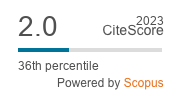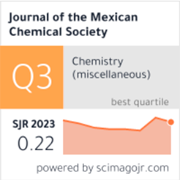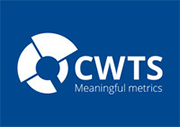von Neumann Entropies Analysis in Hilbert Space for the Dissociation Processes of Homonuclear and Heteronuclear Diatomic Molecules
DOI:
https://doi.org/10.29356/jmcs.v52i1.1042Keywords:
Quantum Information Theory, entanglement, diatomic molecules, Ab initio calculationsAbstract
Quantum Information Theory is a new field with potential implications for the conceptual foundations of Quantum Mechanics through density matrices. In particular, information entropies in Hilbert space representation are highly advantageous in contrast with the ones in phase space representation since they can be easily calculated for large systems. In this work, novel von Neumann conditional, mutual, and joint entropies are employed to analyze the dissociation process of small molecules, Cl2 and HCl, by using the spectral decomposition of the first reduced density matrix in natural atomic orbital-based representation which allows us to assure rotational invariance, N- and v-representability in the Atoms-in-Molecules (AIM) scheme. Quantum information entropies permit to analyze the dissociation process through quantum mechanics concepts such as electron correlation and entanglement, showing interesting critical points which are not present in the energy profile, such as charge depletion and accumulation, along with bond breaking regions.
Downloads
References
2. Bouwmeester, D.; Pan, J.-W.; Mattle, K.; Eibl, M.; Weinfurter, H.; Zeilinger, A. Nature 1997, 390, 575-579.
3. Boschi, D.; Branca, S.; De Martini, F.; Hardy, L.; Popescu S. Phys. Rev. Lett. 1998, 80, 1121-1125.
4. Braunstein, S. L.; Kimble, H. J. Nature 1998, 394, 841-841.
5. Bouwmeester, D.; Mattle, K.; Pan, J.-W.; Weinfurter, H.; Zeilinger, A.; Zukowski, M. Appl. Phys. B 1998, 67, 749-752.
6. Furusawa, A.; Sørensen, J. L.; Braunstein, S. L.; Fuchs, C.A.; Kimble, H. J.; Polzik, E. S. Science 1998, 282, 706-709.
7. Krüger, T. Eur. Phys. J. D. 2001, 14, 299-307.
8. Moffitt, W. Proc. R. Soc. London, Ser. A 1951,210, 245-268.
9. Mulliken, R. S. J. Chem. Phys. 1935, 3, 573-585.
10. Mulliken, R. S. J. Chem. Phys. 1955, 23, 1833-1840.
11. Bader, R. F. W. An Introduction to the Structure of Atoms and Molecules Clarke, Toronto, 1970.
12. Bader, R. F. W. Atoms in Molecules (Oxford, New York, 1994).
13. Bader, R. F. W. and T. T. Nguyen-Dang. Adv. Quantum Chem. 1981, 14, 63-124.
14. Hirshfeld, F. L. Theor. Chim. Acta 1977 44, 129-138.
15. Parr; R. G.; Donnelly, R. A.; Levy, M.; Palke, W. E. J. Chem. Phys. 1978, 68, 3801-3807.
16. Parr, R. G. Int. J. Quantum Chem. 1984, 26, 687-692.
17. Rychlewski, J.; Parr, R. G. J. Chem. Phys. 1986, 84, 1696-1703.
18. Li, L.; Parr, R. G. J. Chem. Phys. 1986, 84, 1704-1711.
19. Cedillo, A.; Chattaraj, P. K.; Parr, R. G. Int. J. Quantum Chem. 2000, 77, 403-407.
20. Ayers, P. J. Chem. Phys., 2000, 113, 10886-10898.
21. Esquivel, R. O.; Rodríguez, A. L.; Sagar, R. P.; Ho, M.; Smith Jr., V. H. Phys. Rev. A 1996, 54, 259-265.
22. Ramírez, J. C.; Soriano, C.; Esquivel, R. O.; Sagar, R. P.; Ho, M.; Smith Jr., V. H. Phys. Rev. A 1997, 56, 4477-4482.
23. Ziesche, P.; Gunnarsson, O.; John, W. Phys. Rev. B 1997, 55, 10270-10277.
24. Guevara, N. L.; Sagar, R. P.; Esquivel, R. O. Phys. Rev. A 2003, 67, 012507-1 – 012507-6.
25. Guevara, N. L.; Sagar, R. P.; Esquivel, R. O. J. Chem. Phys. 2005, 122, 084101-1 – 084101-8.
26. Sen, K. D.; Antolin, J.; Angulo, J. C. Phys. Rev. A 2007, 76, 032502-1 – 032502-7.
27. Sen, K. D.; Panos, C. P.; Chatsisavvas, K. Ch.; Moustakidis, Ch. C. Phys. Lett. A 2007, 364, 286-290.
28. Amovilli, C.; March, N. H. Phys. Rev. A 2004, 69, 054302-1 - 054302-4.
29. Huang, Z.; Kais, S. Chem. Phys. Lett. 2005, 413, 1-5
30. Huang Z; Wang H; Kais, S. J. Mod. Op. 2006, 53, 2543-2558.
31. Esquivel, R. O.; Flores-Gallegos, N. Phys. Rev. A (to be published).
32. Flores-Gallegos, N.; Esquivel, R. O. J. Comp. App. Math. (to be published).
33. Carrera, E.; Flores-Gallegos, N.; Esquivel; R. O. J. Comp. App. Math. in press, 2008.
34. Shannon, C. E.; Weaver, W. 1949, The Mathematical Theory of Communication (University of Illinois, Urbana, IL).
35. Kullback, S.; Leibler, R. A. Ann. Math. Stat. 1951, 22, 79-86.
36. For an earliest application of Kullback-Leibler measure see Raju K.B.K., Nair P. &V. and Sen K.D. Chem. Phys. Lett. 1990, 170, 89-93.
37. Einstein, A.; Podolsky, B; Rosen, N. Phys. Rev. 1935, 47, 777-780.
38. Bell, J., Speakable and Unspeakable in Quantum Mechanics 1987 (Cambridge University, Cambridge).
39. von Neumann, J., Mathematical Foundations of Quantum Mechanics, 1955 translated from the German ed. by R. T. Beyer (Princeton University, Princeton).
40. Wehrl, A. Rev. Mod. Phys. 1978, 50, 221-260.
41. Vedral, V. Rev Mod. Phys. 2002, 74, 197-234.
42. Araki, H.; Lieb, E. H. Commun. Math. Phys. 1970, 18, 160-170.
43. Lowdin P.O. Adv. Quantum Chem. 1970, 5, 185-199; Lowdin P.O. J. Chem. Phys. 1950, 18, 367-370.
44. Reed, A. E.; Weinhold, F. J. Chem. Phys. 1983, 78, 4066-4073.
45. Davidson, E. R. J. Chem. Phys. 1967, 46, 3320-3324.
46. Reed, A. E.; Weinstock, R. B; Weinhold, F. J. Chem. Phys. 1985, 83, 735-746.
47. Bruhn, G.; Davidson, E. R.; Mayer, I..; Clark, A. E. Int. J. Quantum Chem. 2006, 106, 2065-2072.
48. Nalewajski, R. F. Chem. Phys. Lett. 2003, 372, 28-34.
49. Rajagopal, A. K.; Rendell, R. W. Phys. Rev. A 2002, 66, 022104-1- 022104-10.
50. Cerf, N. J.; Adami; C. Phys. Rev. Lett. 1997, 79, 5194-5197.
51. Gaussian 03, Revision D.01, Frisch, M. J.; Trucks, G. W.; Schlegel, H. B.; Scuseria, G. E.; Robb, M. A.; Cheeseman, J. R.; Montgomery Jr., J. A.; Vreven, T.; Kudin, K. N.; Burant, J. C.; Millam, J. M.; Iyengar, S. S.; Tomasi, J.; Barone, V.; Mennucci, B.; Cossi, M.; Scalmani, G.; Rega, N.; Petersson, G. A.; Nakatsuji, H.; Hada, M.; Ehara, M.; Toyota, K.; Fukuda, R.; Hasegawa, J.; Ishida, M.; Nakajima, T.; Honda, Y.; Kitao, O.; Nakai, H.; Klene, M.; Li, X.; Knox, J. E.; Hratchian, H. P.; Cross, J. B.; Bakken, V.; Adamo, C.; Jaramillo, J.; Gomperts, R.; Stratmann, R. E.; Yazyev, O.; Austin, A. J.; Cammi, R.; Pomelli, C.; Ochterski, J. W.; Ayala, P. Y.; Morokuma, K.; Voth, G. A.; Salvador, P.; Dannenberg, J. J.; Zakrzewski, V. G.; Dapprich, S.; Daniels, A. D.; Strain, M. C.; Farkas, O.; Malick, D. K.; Rabuck, A. D.; Raghavachari, K.; Foresman, J. B.; Ortiz, J. V.; Cui, Q.; Baboul, A. G.; Clifford, S.; Cioslowski, J.; Stefanov, B. B.; Liu, G.; Liashenko, A.; Piskorz, P.; Komaromi, I.; Martin, R. L.; Fox, D. J.; Keith, T.; Al-Laham, M. A.; Peng, C. Y.; Nanayakkara, A.; Challacombe, M.; Gill, P. M. W.; Johnson, B.; Chen, W.;Wong, M. W.; Gonzalez, C.; Pople, J. A. 2004, Gaussian, Inc., Wallingford CT,
52. NBO 5.0. Glendening; E. D.; Badenhoop; J K.; Reed, A. E.; Carpenter, J. E.; Bohmann, J. A.; Morales, C. M.; and Weinhold, F. Theoretical Chemistry Institute 2001, University of Wisconsin, Madison.
53. MOLDEN: a pre- and post-processing program for molecular and electronic structures. J. Comput.-Aided Mol. Design 2000, 14,123-134.
54. It has been recently shown (Subin Liu, J.Chem. Phys. 2007, 126, 191107-1 - 191107-3) that the integrand of the Fisher measure of information may be expressed as the Laplacian of the density times log density, hence depletion/accumulation is multiplied by a relative entropy, i.e. log [rho(r)/1.0] in this new definition of Fisher measure. This explains the relevance of information measures in deciphering the local bonding charateristics.
55. Boys, S. F.; Bernardi, F. Mol. Phys. 1970, 19, 553-566.
56. Liu B.; McLean, A. D. J. Chem. Phys. 1973, 59, 4557-4558.
Downloads
Published
Issue
Section
License
Authors who publish with this journal agree to the following terms:
- Authors retain copyright and grant the journal right of first publication with the work simultaneously licensed under a Creative Commons Attribution License that allows others to share the work with an acknowledgement of the work's authorship and initial publication in this journal.
- Authors are able to enter into separate, additional contractual arrangements for the non-exclusive distribution of the journal's published version of the work (e.g., post it to an institutional repository or publish it in a book), with an acknowledgement of its initial publication in this journal.









